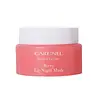What's inside
What's inside
 Key Ingredients
Key Ingredients

 Benefits
Benefits

 Concerns
Concerns

 Ingredients Side-by-side
Ingredients Side-by-side

Ethylhexyl Palmitate
EmollientPolyisobutene
Hydrogenated Poly(C6-20 Olefin)
AbrasivePolyethylene
AbrasiveHydrogenated Styrene/Isoprene Copolymer
Methyl Hydrogenated Rosinate
PerfumingParaffinum Liquidum
EmollientPhytosteryl Oleate
Skin ConditioningTocopheryl Acetate
AntioxidantParfum
MaskingNeotame
MaskingWater
Skin ConditioningCocos Nucifera Oil
MaskingAloe Barbadensis Leaf Extract
EmollientPentaerythrityl Tetra-Di-T-Butyl Hydroxyhydrocinnamate
AntioxidantVaccinium Angustifolium Fruit Extract
Skin ProtectingButylene Glycol
HumectantPhenoxyethanol
PreservativeHydroxyacetophenone
AntioxidantEthylhexylglycerin
Skin ConditioningCinnamyl Alcohol
PerfumingLinalool
PerfumingCI 42090
Cosmetic ColorantCI 45410
Cosmetic ColorantCI 19140
Cosmetic ColorantEthylhexyl Palmitate, Polyisobutene, Hydrogenated Poly(C6-20 Olefin), Polyethylene, Hydrogenated Styrene/Isoprene Copolymer, Methyl Hydrogenated Rosinate, Paraffinum Liquidum, Phytosteryl Oleate, Tocopheryl Acetate, Parfum, Neotame, Water, Cocos Nucifera Oil, Aloe Barbadensis Leaf Extract, Pentaerythrityl Tetra-Di-T-Butyl Hydroxyhydrocinnamate, Vaccinium Angustifolium Fruit Extract, Butylene Glycol, Phenoxyethanol, Hydroxyacetophenone, Ethylhexylglycerin, Cinnamyl Alcohol, Linalool, CI 42090, CI 45410, CI 19140
Polyisobutene
Paraffinum Liquidum
EmollientPetrolatum
EmollientDiisostearyl Malate
EmollientBeeswax
Emulsion StabilisingEuphorbia Cerifera Wax
Hydrogenated Styrene/Isoprene Copolymer
Ceresin
Emulsion StabilisingSorbitan Sesquioleate
EmulsifyingCaprylyl Glycol
EmollientParfum
MaskingTitanium Dioxide
Cosmetic ColorantPolyglyceryl-2 Triisostearate
EmulsifyingSynthetic Fluorphlogopite
1,2-Hexanediol
Skin ConditioningTocopheryl Acetate
AntioxidantCI 19140
Cosmetic ColorantCI 15850
Cosmetic ColorantTin Oxide
AbrasiveWater
Skin ConditioningOlea Europaea Fruit Oil
MaskingButylene Glycol
HumectantMacadamia Integrifolia Seed Oil
Skin ConditioningTocopherol
AntioxidantLavandula Angustifolia Flower Extract
CleansingRosa Canina Flower Extract
AstringentChamomilla Recutita Flower Extract
MaskingPaeonia Officinalis Flower Extract
TonicRosa Centifolia Flower Extract
AstringentCamellia Japonica Flower Extract
EmollientLilium Tigrinum Extract
Skin ConditioningRubus Idaeus Fruit Extract
AstringentFragaria Chiloensis Fruit Extract
Skin ConditioningPunica Granatum Fruit Extract
AntioxidantTricholoma Matsutake Extract
Skin ConditioningNelumbo Nucifera Flower Extract
Skin ConditioningSchisandra Chinensis Fruit Extract
Skin ConditioningPanax Ginseng Root Extract
EmollientMoringa Oleifera Seed Extract
Skin ConditioningPolyisobutene, Paraffinum Liquidum, Petrolatum, Diisostearyl Malate, Beeswax, Euphorbia Cerifera Wax, Hydrogenated Styrene/Isoprene Copolymer, Ceresin, Sorbitan Sesquioleate, Caprylyl Glycol, Parfum, Titanium Dioxide, Polyglyceryl-2 Triisostearate, Synthetic Fluorphlogopite, 1,2-Hexanediol, Tocopheryl Acetate, CI 19140, CI 15850, Tin Oxide, Water, Olea Europaea Fruit Oil, Butylene Glycol, Macadamia Integrifolia Seed Oil, Tocopherol, Lavandula Angustifolia Flower Extract, Rosa Canina Flower Extract, Chamomilla Recutita Flower Extract, Paeonia Officinalis Flower Extract, Rosa Centifolia Flower Extract, Camellia Japonica Flower Extract, Lilium Tigrinum Extract, Rubus Idaeus Fruit Extract, Fragaria Chiloensis Fruit Extract, Punica Granatum Fruit Extract, Tricholoma Matsutake Extract, Nelumbo Nucifera Flower Extract, Schisandra Chinensis Fruit Extract, Panax Ginseng Root Extract, Moringa Oleifera Seed Extract
 Reviews
Reviews

Ingredients Explained
These ingredients are found in both products.
Ingredients higher up in an ingredient list are typically present in a larger amount.
Butylene Glycol (or BG) is used within cosmetic products for a few different reasons:
Overall, Butylene Glycol is a safe and well-rounded ingredient that works well with other ingredients.
Though this ingredient works well with most skin types, some people with sensitive skin may experience a reaction such as allergic rashes, closed comedones, or itchiness.
Learn more about Butylene GlycolCI 19140 is also known as Tartrazine. Tartrazine is a synthetic dye used in cosmetics, foods, and medicine to add a yellow color.
Tartrazine is created from petroleum and is water-soluble.
Some people may experience allergies from this dye, especially asthmatics and those with an aspirin intolerance.
Learn more about CI 19140We don't have a description for Hydrogenated Styrene/Isoprene Copolymer yet.
Paraffinum Liquidum is also known as liquid paraffin. It is a type of highly refined mineral oil.
Like other oils, Paraffinum Liquidum has emollient properties. Emollients help soothe and soften the skin. By creating a barrier to trap moisture within, emollients help keep your skin hydrated.
Paraffinum Liquidum does not irritate the skin and is non-comedogenic.
Learn more about Paraffinum LiquidumParfum is a catch-all term for an ingredient or more that is used to give a scent to products.
Also called "fragrance", this ingredient can be a blend of hundreds of chemicals or plant oils. This means every product with "fragrance" or "parfum" in the ingredients list is a different mixture.
For instance, Habanolide is a proprietary trade name for a specific aroma chemical. When used as a fragrance ingredient in cosmetics, most aroma chemicals fall under the broad labeling category of “FRAGRANCE” or “PARFUM” according to EU and US regulations.
The term 'parfum' or 'fragrance' is not regulated in many countries. In many cases, it is up to the brand to define this term.
For instance, many brands choose to label themselves as "fragrance-free" because they are not using synthetic fragrances. However, their products may still contain ingredients such as essential oils that are considered a fragrance by INCI standards.
One example is Calendula flower extract. Calendula is an essential oil that still imparts a scent or 'fragrance'.
Depending on the blend, the ingredients in the mixture can cause allergies and sensitivities on the skin. Some ingredients that are known EU allergens include linalool and citronellol.
Parfum can also be used to mask or cover an unpleasant scent.
The bottom line is: not all fragrances/parfum/ingredients are created equally. If you are worried about fragrances, we recommend taking a closer look at an ingredient. And of course, we always recommend speaking with a professional.
Learn more about ParfumPolyisobutene is a synthetic polymer made from isobutene.
It is a film-forming agent and helps bind ingredients together.
Polyisobutene is not absorbed by the skin.
Learn more about PolyisobuteneTocopheryl Acetate is AKA Vitamin E. It is an antioxidant and protects your skin from free radicals. Free radicals damage the skin by breaking down collagen.
One study found using Tocopheryl Acetate with Vitamin C decreased the number of sunburned cells.
Tocopheryl Acetate is commonly found in both skincare and dietary supplements.
Learn more about Tocopheryl AcetateWater. It's the most common cosmetic ingredient of all. You'll usually see it at the top of ingredient lists, meaning that it makes up the largest part of the product.
So why is it so popular? Water most often acts as a solvent - this means that it helps dissolve other ingredients into the formulation.
You'll also recognize water as that liquid we all need to stay alive. If you see this, drink a glass of water. Stay hydrated!
Learn more about Water